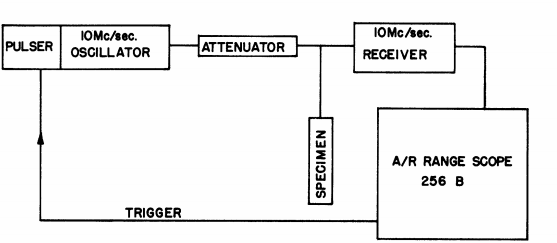A pulsed technique at 10 Mc/sec has been used to measure acoustic velocity and attenuation of several alkali halides and Rochelle salt. Values for the elastic moduli of LiF, NaOil, EBr, and I have been determined. The attenuation of the ultrasonic beam in these media is mall. Corresponding measurements on the elastic moduli of Rochelle salt are reported. Under the assumption of plane-wave transmission many of these moduli automatically correspond to those measured on foiled crystals by other methods. Attenuation is considerable in Rochelle salt, and appears to be excessively high for transmission involving the temperature-dependent 44 (foiled case). Where this modulus is involved, marked effects have been observed from electric bias and mechanical pressure. A complete set of elastic moduli has been obtained and used to calculate the corresponding values for the moduli of compliance.
The recent development of short-pulse techniques has made available pulsed ultrasonics as a very convenient tool for investigating the mechanical properties of matter. During the war, some work was carried out on liquids at the Radiation Laboratory at Massachusetts Institute of Technology. More recently a systematic study of the velocity and absorption of certain organic liquids has been performed by workers in this laboratory. Some research on solids has been done as part of the war effort in England and also in this country. The pulsed technique has also been used as a tool for detecting mechanical flaws in solids.
Recently, the most widely used technique for measuring ultrasonic velocity and absorption in single crystals has been the composite oscillator method initiated by Qaimby's students8 whereby a piezoelectric crystal is cemented to the specimen under test and the frequency is varied to obtain a resonance. Information on the velocity and elastic constants is obtained from the frequency of resonance. The breadth of the resonance measures the damping or internal friction.

Fig1
Quartz crystals were used for electromechanical transducers. In general, the same crystal, attached through a T-connector, was used to transmit and receive. The specimen under test was clamped in place on a small brass table with the crystal fastened to the prepared surface. The TJunction was physically near the amplifier input add transforming networks were not employed. Attenuation measurements were made only when sufficient attenuation had been inserted so that the driving impedance at the Junction was effectively 70 ohms.
The preparation of electrodes for crystals to be used with alkali halides and Rochelle salt was complicated by the fact that the surfaces of these materials could not be cleaned by usual reagents. or this reason it appeared inadvisable to attempt to apply metal electrodes either by evaporation or Brashearis process. The interposition of a metal foil between crystal and specimen was undesirable since a second binding film would be needed between foil and specimen. Under such circumstances the production of good pulse shapes would have been difficult. Instead, electrodes were deposited on the crystal itself by the Brashear process so that the whole crystal, 1 in. in diameter, was plated everywhere except for a centered ring of bare quartz on one face. The inner and outer diameters of the ring were 0.5 in. and 0.75 in., respectively. The completely silvered face was attached to the specimen while on the other side press-fingers of beryllium copper made ground connection to the outer ring and a steel spring formed a coaxial lead to excite the central, silvered spot.
上一篇: 单层和双层石墨烯大单晶的化学气相沉积生长
下一篇: 单分子单晶晶体中的激光振荡